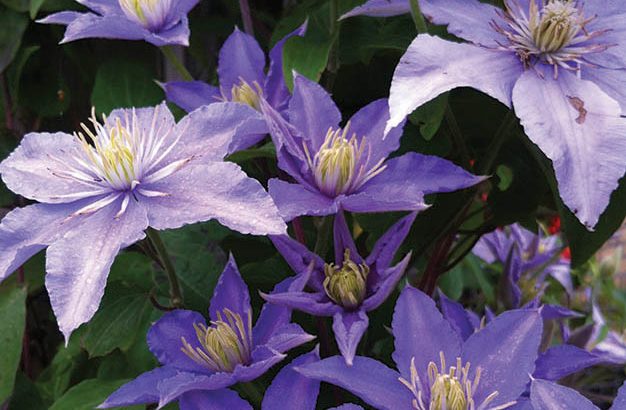There is a clematis in flower along our fence, big, rich, flouncy purple flowers. The sepals are feathery with a darker purple rib running the length of them. At the heart of the flower are stamens, purple merging to an almost lime green. Next to it is a hydrangea. Lilac-fading-to-white florets surround a head of tiny purple, lavender and lilac flower beads in a beautiful shape which I’m told is a lacecap. The palette of purples draws my eye every time. Maybe if I was a decent gardener, I could claim to have planned this but in reality, I am not and the juxtaposition is entirely accidental.
And it is not simply that these are beautiful. They are also involved in wondrous processes as my home-grown scientists explained to me. With every breath we expel carbon dioxide and the plants draw this from the air. Then taking water from the earth through their roots and using light from the sun they split the water atoms into protons and electrons creating glucose energy for growth and releasing oxygen back into the atmosphere. We are caught up in a wonderful circle of life with the plants in our garden!
These plants are beautiful and their beauty does not depend on me being here to gaze on them. If this hydrangea was to grow in the middle of a forest, unseen by anyone it would still be beautiful, still amazing, still a testament to the wonder of God the creator. How often I underestimate this when I casually think, “Ah sure it’s a grand flower”.
So much of our modern lifestyle creates a disconnect between us and the rest of creation. Too often the purpose of life is constructed in terms of what we possess, what our money can buy. As a result we can look upon the natural world as simply something which is there for our use and consumption. We lose our sense of wonder and reverence. As Pope Francis says, we become disenchanted with the universe. When that happens, it reinforces a flat, functional, consumerist attitude towards the Earth’s resources. Such an attitude can even extend to how we treat other people – there for our use, disposable, – and even our capacity for faith. When we lose our capacity for wonder and awe we become disconnected from the Spirit.
The Season of Creation is celebrated in the Christian Churches and beyond from 1st September to 4th October, the Feast Day of St Francis. Surely this is a time to reawaken in ourselves and our children that sense of wonder which sees creation as a tapestry of revelation woven by Spirit.
One way is simply to take time to contemplate the natural world – whether that is the spider’s web on a gate or the simple beauty and complexity of a flower. Then of course there is also science and remember, Pope Francis was a scientist before he was a priest. Rather than being an obstacle to faith, science can be a wonderful way of engaging with the natural world. The more we understand the more we realise there is to explore. As with faith, glimpses of knowing invite us deeper into the riches of our unknowing. How does a flower grow? How does this swallow find its way here from the plains of Africa? How does that caterpillar know it needs to cocoon to become a butterfly? That sense of curiosity can help us rediscover the universe as a place of wonder – a place that speaks to us of the creative energy of God.
Pope Francis in Laudato Si’ makes it clear that if we are to address the challenges of climate crisis we need to rediscover a deep reverence for the natural world and for each other. Ultimately we need to realise that we are an integral part of that community of creation.


 Bairbre Cahill
Bairbre Cahill
